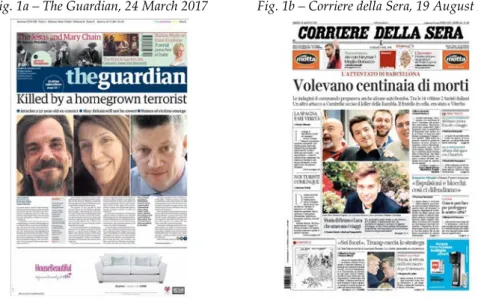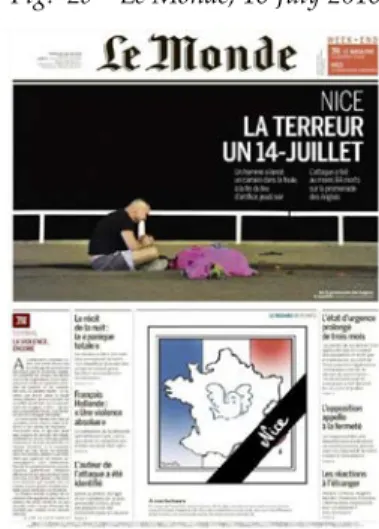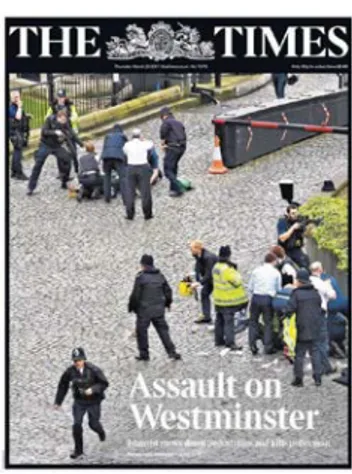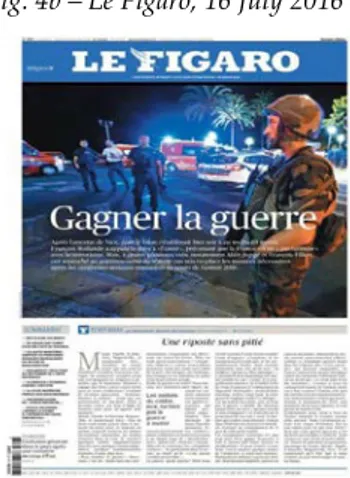The Representation of Terror and Moral Panics:
The Media Frames of the European press
EMANUELA PECE How to cite
Pece, E. (2018). The Representation of Terror and Moral Panics: The Media Frames of the European press. Journal of Mediterranean Knowledge-JMK, 3(1), 87-99. DOI: 10.26409/2018JMK3.1.06
Retrieved from
http://www.mediterraneanknowledge.org/publications/index.php/journal/issue/archive
1. Author’s information
University of Salerno, Italy
2. Author’s contact
Article first published online: June 2018
- Peer Reviewed Journal
Additional information about Journal of Mediterranean Knowledge-JMK
Journal of Mediterranean Knowledge-JMK, 2018, 3(1), 87-99 − ISSN: 2499-930X DOI: 10.26409/2018JMK3.1.06
The Representation of Terror and Moral Panics:
The Media Frames of the European press
Emanuela Pece University of Salerno, Italy
Abstract
People’s attitudes and behaviours are influenced by their perception of Others and expectations towards them, in connection with their social and cultural context. These dynamics are strongly influenced by the information transmitted by the mass media, in their dual role as both mediators of reality and opinion leaders. Sometimes, the information transmitted can be a “distorted reflection” of reality; for example, news about terrorist attacks by more or less organized groups or the murderous anger of a single individual (in our cases, a motor vehicle rammed into the crowd) often serve as a sounding board for certain social issues, such as crime and security for people and communities. This work aims at illustrating, through an analysis on media frames (both iconographic and textual), which types of representations the European press offers to its readers in the narration of certain events linked to terrorism and how such representations can affect (or not) the creation of generalized alarm phenomena (moral panics).
Keywords: Communication, Mass media, Moral panics, Terror, Terrorism.
1. Moral panics between representations and media frames
In their dual role of mediators with reality and filters of information, the mass media introduce in their narrative circuit some episodes that are, in turn, “transformed” into news (the so-called newsmaking process – Wolf, 2001). However, in everyday life there are events and problems that prevail and assert themselves for their uniqueness and importance; furthermore, in this continuous flow of events people are unable to have a first-hand experience and a direct knowledge of what is happening. The mass media play an important role in filtering these events, representing slices of reality (McCombs & Shaw, 1972) to an audience that often has no direct nor indirect knowledge of them. Within these representations there are events and/or people who, in some cases, can contribute in forming images of a cultural Other with which people establish a form of relationship. The modalities of perception for these types of relationships are various and
they are often linked to a series of factors, mainly social and cultural ones; therefore, the perception of a cultural Other as a threat can influence, in some cases, a given relationship. In general, the perception of the Other as a threat to one’s own security, to that of the community to which one belongs or to society in general is connected to the cultural system of reference; however, it must be pointed out that the perception of a risk does not always correspond to a “real” danger. For example, Stephan and Stephan (1996) envisage four types of threats: stereotypes, realistic threats, symbolic threats and inter-group anxiety. Realistic and symbolic threats refer to the perception of a threat to both security and the cultural system coming from groups of individuals who have different interests (economic, political and material) and lifestyles.
In these situations, the perception of a danger can be influenced and amplified by the presence of the mass media which, voluntarily (or not), contribute to moral panic processes. The term moral panic refers to the perception of a widespread climate of concern and social alarm and is often linked to the presence of certain groups described as deviant, dangerous, or as a general threat to the security and values of a society (Maneri, 2001). This perception inevitably influences the relationship with a cultural Other and with all those who are considered as belonging to the Others out-group (Gili, 2009). But moral panic rests its existence on “concrete” bases, that is, on problems and themes that exist in people’s daily lives but are perceived as general, social problems. According to Hilgartner and Bosk (1988) all “real” problems can potentially be social problems; civil society, is considered as a real arena within which a competition takes place between situations that can be defined as social problems. When some of these situations are selected as social problems they may respond to specific characteristics: they can therefore be dramatized, they deal with themes rooted in a culture, or they are linked to powerful interest groups (ibid.).
In the above dynamics, the mass media can not only help in reducing or reinforcing the distances in the relationship with a cultural Other, but they can also over-expose and over-dimension some episodes. In turn, the latter may not only provide a distorted representation of reality (Gerbner & Gross & Morgan & Signorielli, 2002), but at the same time they can create widespread alarm within society. Terrorism shows how “real” episodes, i.e. terrorist attacks, can give rise, in some cases, to psychosis and generalized alarm.
The Representation of Terror and Moral Panics: The Media Frames of the European press
Journal of Mediterranean Knowledge-JMK, 2018, 3(1), 87-99 − ISSN: 2499-930X
DOI: 10.26409/2018JMK3.1.06 89
Therefore, one can no longer speak exclusively of the communication of “risk” or danger, but in some cases, there is a real communication risk (Mangone, 2015). One risk is without doubt the possibility of perverse effects (Boudon, 1977) produced by a communicative event: unwanted or at least unanticipated effects and consequences of media messages on individuals, which can create further crisis situations that need to be managed. An example of a perverse effect correlated to the increase of generalized panic and uncertainty is the multiplication of false bomb alarms or alarmism due to the presence of individuals or vehicles in a certain place (Mangone & Pece, 2017).
Since 2001, moreover, terrorism has evolved its communication strategies, relying more and more on visual communication (Morcellini, 2015) focused on the use of images (e.g. the videos of executions, death and devastation) to vehicle contents and information.
If we consider the images of individuals produced and re-produced in the representations of terrorism-related events and episodes, we notice that the “human figure” becomes an essential element when the narrations raise the presence of an anti-subject (Cosenza, 2007), an enemy against whom one fights, an Other who must (or should) have very specific physical characteristics and in whose absence the perception of risk and fear inevitably tends to amplify. In 2001, for example, Osama Bin Laden represented the evil against whom Americans and the rest of the world were called upon to fight; conversely, today it is increasingly difficult to define and trace the identity and faces of “the enemy”. For this reason, episodes linked to terrorism can become “activators” of moral panic, strengthening the idea of what we might call the “society of fear” (Morcellini, 2015).
2. Terrorism: an analysis of media frames
This pilot study takes into consideration some of the major cases directly or indirectly related to Islamic terrorist actions in Europe, united by a same mode of action: a truck rammed into the crowd. In chronological order, we have: Nice, 14 July 2016; Berlin, 19 December 2016; London, 22 March 2017; Stockholm, 7 April 2017; London, 3 June 2017 and, finally, Barcelona, 17 August 2017.
The analysis takes into account the way in which the Italian and European press have dealt with each case, considering, for research purposes, the two days following the event. For the collection of the front pages of the newspapers we consulted the Googlenews research archives using as keywords the “place” and the day after the event took place (e.g. Nice, July 15, 2017). The newspapers considered are representative of each reality, as they are the larger ones by circulation. In particular, we have examined: Il Corriere della Sera and La Repubblica (Italy), Le Monde and Le Figaro (France), El Pais and El Mundo (Spain), The Guardian, The Independent and The Times (United Kingdom). The research looks at the media presentation of the cases, paying particular attention to the interpretative frames encasing each event, which may or may not influence their interpretation and which, in some cases, may help in creating (or strengthening) a sense of generalized alarm (moral panics). The latter aspect will be evaluated taking into account some contemporaneous surveys, estimating, as far as possible, the perception of the phenomenon of terrorism and the risk of attacks in one’s own country.
The inductive methodology adopted is linked to the so-called grounded theory (Glaser & Strauss, 1967), applying a “funnel-like” structure to the data, starting from details to reach a wider explanation, a universal. In this method, the derived theory defines a number of concepts that explain specific events (Silverman, 2000) – such as, in this case, moral panic phenomena.
The organisation of the contents of the various articles share a fixed narrative structure across all newspapers, characterised by three main points: 1) description of the episode in line with the “5W rule”; 2) attention to the reconstruction of the dynamics of the actions and the roles of the “protagonists” (reconstruction of the profile of the perpetrators of the attack, of the victims and the wounded); 3) presence or absence of in-depth analyses linked to social themes and problems connected to the matter (for example, the discourse on the security of the cities, on the strategies for the prevention of future attacks and on the measures adopted for the fight against terrorism).
Particular importance was given to the iconographic aspect: images and videos (especially amateur ones) seem to dramatically “enrich” each event by suggesting the descriptive tones of the newspapers (Pece, 2018). Based
The Representation of Terror and Moral Panics: The Media Frames of the European press
Journal of Mediterranean Knowledge-JMK, 2018, 3(1), 87-99 − ISSN: 2499-930X
DOI: 10.26409/2018JMK3.1.06 91
on this specificity, we identified three types of photos that suggest three types of media frames. We should remember that media frames are a multidimensional concept described as a set of verbal, visual and symbolic contents, which, reorganized in a text, constitute a pivotal moment in the construction of meanings (Reese, 2001).
On the basis of the above, we identified the following types of frames. We will start with what we defined as Human Drama Frames. This type includes photographs that focus mainly on the reader’s emotions, underlining the dramatic nature of the event and reinforcing the human dimension. The images also illustrate the “faces” of the victims, while the texts add, in a few lines, short biographies. In addition to the quantitative dimension (dictated by expressions, such as: hundreds of dead, many wounded) there is a purely qualitative dimension providing elements that help to define the specific identity of each victim (such as, for example, the name, the age of the person). The process of personification of the victims thus accentuates the human dimension of the frame within which the entire story is told and represented (Figures 1a and 1b).
Fig. 1a – The Guardian, 24 March 2017 Fig. 1b – Corriere della Sera, 19 August 2017
The textual component that strengthens the dimension of the “human drama” is mainly constituted by terms and expressions such as strage;
massacre; terrore; terror; “the night of terror”; horror; “l'horreur au coeur de Berlin”; “la terreur un 14- juillet”; “lacrime italiane per Fabrizia”.
The representation of the human dimension, linked to the seriousness of the episodes, is reinforced by the presence of images illustrating the despair of the survivors and the moments of commemoration of the victims (Figures 2a, 2b and 2c).
Fig. 2a – Le Figaro, 18 August 2017
Fig. 2b – Le Monde, 16 July 2016
The Representation of Terror and Moral Panics: The Media Frames of the European press
Journal of Mediterranean Knowledge-JMK, 2018, 3(1), 87-99 − ISSN: 2499-930X
DOI: 10.26409/2018JMK3.1.06 93
The second type of frames refers to a group of images capable of independently representing the news (Papuzzi, 2010) followed by short, essential captions. We have defined this type as Reality Frames; in this sense, the media frame represents a window onto the world (Tuchman, 1978) within which the narrative of events is entrusted to the role of images trying to give a sort of “objectivity” to the news (Figures 3a, 3b, 3c).
Fig. 3a – El Mundo, 18 August 2017 Fig. 3b – The Times, 23 March 2017
Fig. 3c – Corriere della Sera, 8 April 2017
Photos play an important role because the readers may see in them places and environments that are “familiar” to them (shopping malls,
squares, streets, restaurants); consequently, the perception of risk and the relative fear may increase.
The last group consists mainly of images (and titles) that evoke, in some ways, a narrative stereotype closely linked to a “war scenario”. Thus, there is a clear contrast between the “good” (Figures 4a and 4b) and the “bad” in which attempts are made to reconstruct the profile of the bomber(s) (Figure 4c), the “weapons” (Figure 4d) – such as, for example, the very truck rammed into the crowd – and, finally, the places where the “clash” took place (Figure 4e). These elements define a third and final frame type: The War Frames.
Fig. 4a – The Guardian, 5 June 2017 Fig. 4b – Le Figaro, 16 July 2016
The Representation of Terror and Moral Panics: The Media Frames of the European press
Journal of Mediterranean Knowledge-JMK, 2018, 3(1), 87-99 − ISSN: 2499-930X
DOI: 10.26409/2018JMK3.1.06 95
Fig. 4d – Le Monde, 20 December 2017 Fig. 4e – The Times, 23 March 2017
As for the textual aspect, some words and expressions frequently recur in the representation of events, all closely related to the semantic sphere of war, such as: attacco, truck attacker, attack, attentato, terror strikes; “El terror del IS golpea España”, la matanza de Berlin. As far as the terrorists’ profile is concerned, together with more “neutral” and generic words, among which the attacker, l’attentatore, the killer, the terrorist cell, the young terrorists, we find more detailed descriptions: the attacker of the Nice massacre of 14 july 2016 is a “franco tunisino di 31 anni” [31-year-old Franco-Tunisian] (La Repubblica, 14 July 2016), or, that of 22 March 2017 in London is a “un assassino di 52 anni” [a 52-year-old killer] (La Repubblica, 22 March 2017). The attempt to give terrorists “a name and a face” is explained by the fact that the enemy increasingly assumes the characters of an invisible threat (Farci, 2006), to the point of considering the terrorist threat intrinsically spectral and invisible (Žižek, 2005). Furthermore, from an idea of the enemy as foreign and external (if we think, for example, of the Twin Towers attacks in 2001), we move to a perception of an enemy that is “nearer”, “closer”, thus it can be a Muslim convert (The Times, 24 March 2017), or a homegrown terrorist (The Guardian, 23 March 2017): the “closeness” of the enemy greatly increases the perception of a danger that is more “near” and, therefore, real. Moral panic is not only linked to the perception of the enemy, but also to the idea of a real danger that threatens people’s daily
lives; so, terror (and not the terrorist, as a “natural person” author of possible attacks) affects “Christmas” as it was in Berlin, or July 14 has become for the French the Bastille Day massacre (The Times, July 15, 2016). 3. Final considerations
The media representation of terrorism seems to stand on two main concepts, hypermediation and immediacy (Bastiani, 2012). The first refers to the use of various means of communication, integrating different communicative levels and languages (films, icons, texts, sound). The second to the immediacy of the news, that is, to the immediate response that the mass media try to offer to the various publics, conveyed in ways that allow, to those who communicate, to come into direct contact with public opinion. These two elements can activate moral panics, given that a greater “closeness” towards certain events and personal experiences (above all those of the victims and their families) corresponds to higher self-identification, thus “other people’s pain” becomes one’s own and the perception of threats and dangers to one’s security becomes more and more concrete.
Since September 11, 2001, the problem of security has undoubtedly worsened, with the emergence fo a global threat (and enemy) capable of undermining the stability and security of individuals (Mangone & Pece, 2017). Starting from the US Patriot Act, there has been a continuous evolution and redefinition of policies on the subject, above all because terrorism “has adopted the tactic of guerrilla warfare that makes unpredictability its strategy. The diversity of terrorist groups and their non-territoriality makes it difficult to identify and control them: anyone could be a fighter and the attacks can come from any point and by any means”1.
The sense of uncertainty and instability is, therefore, one of the elements behind the fear and the constant alert; all aspects that can be measured through the figures produced by statistics and surveys.
1
Osservatorio Sicurezza Nazionale, Costruire una cultura della sicurezza nazionale [Building a culture of national security], 2008, retrieeved 13 December 2016 from http://www.difesa.it/SMD_/CASD/IM/CeMiSS/Pubblicazioni/OSN/Documents/4787_OSN20 08_v3_3.pdf; p. 12.
The Representation of Terror and Moral Panics: The Media Frames of the European press
Journal of Mediterranean Knowledge-JMK, 2018, 3(1), 87-99 − ISSN: 2499-930X
DOI: 10.26409/2018JMK3.1.06 97
For example, in 2016, according to a Eurobarometer survey2, European
citizens drew the attention of public institutions to the issue of personal and occupational safety; their priorities were the fight against terrorism (82%) and that against unemployment (77%). In addition, fear of new terrorist attacks was high; about 40% of Europeans believed that the risk of terrorist attacks to be “real”. Citizens also called for a stronger presence of the European Union in preventing the financing of terrorist organisations (42%), as well as in eradicating the roots of terrorism and radicalisation (41%) and strengthening controls at the Union’s external borders (39%). From the point of view of the perception of a terrorist threat, the situation in Italy has, for some aspects, evolved; the latest ISPI survey (Institute for Studies in International Politics, 2018)3, at the question “What are the
major threats at global level?”, reports that in 2017, only 11% of experts believed that “Islamic terrorism” can be considered a threat, in stark contrast with 2014 when 31% of them considered Islamic terrorism as a threat to global security. To date, the perception of risk, again in the opinion of experts, is represented by a variety of other factors, such as political tensions in North Korea, the crisis in the Middle East and inequalities in the world. On the issue of security in Italy, experts say that the main threats are represented by the economic crisis (30%), the European fragility (26%), immigration (16%) and the unstable situation in Libya (19%). For what concern Italian citizens, it is significant the development of a greater interest in international politics, with an increase of eight percentage points: from 26% in 2014 to 34% in 2017. This interest has grown not only among the normally more informed categories such as entrepreneurs, managers and freelancers, but also among those who were historically less informed such as pensioners (from 30% to 42%) or housewives (from 28% to 36%)4. Italians perceive as a threat mainly
economy-related issues (48%); immigration holds second place with 22% of
2 Eurobarometer, Public opinion in the European Union, (2016), http://ec.europa.eu
/COMMFrontOffice/publicopinion/index.cfm/Survey/getSurveyDetail/instruments/STAND ARD/surveyKy/2130 (accessed on 20 April2018).
3 https://www.ispionline.it/it/tag/sondaggio (accessed on 10 May 2018)
4 Sondaggio ISPI-RaiNews-IPSOS, Gli italiani e la politica internazionale, 20 Dicembre 2017,
https://www.ispionline.it/it/pubblicazione/gli-italiani-e-la-politica-internazionale-19266 (accessed on 10 May 2018).
the respondents mentioning it. Terrorism-related worries are not comparable to those of 2015 (26%), year of the first and most dramatic attacks in Europe (first of all, the Paris attack in November 2015) and the figure has slightly dropped (12%), but it still holds third place as “most serious threat to Italy”. But if Italians do not perceive terrorism as a threat to their own security, a very different situation emerges when we speak of terrorism as a “global” threat; in this case, 23% of Italians put terrorism first, followed by North Korea (16%) and only 12% mention the economic crisis. According to the survey, the decrease in the perception of terrorism as a threat seems to be connected to the territorial defeat of the Islamic State both in Iraq and in Syria; 71% of Italians seems to consider the loss of territory as “the best news of the year”, the one that has apparently given “greater hope in 2017”. It follows that the sample also has a positive view on the role of the institutions, first of all the Italian government: 56% of Italians evaluated positively the management of the Terrorist alert by the Italian government. This figure grew from 2015 to 2017, with a substantial increase, from 17% to 21%, in those who report a very positive evaluation of the government’s performance on the issue.
References
Bastiani, D. (2012). Terrorismo e media. La comunicazione del terrore. Informazioni della Difesa, 2, 36-43.
Boudon, R. (1977). Effects pervers et ordre social. Paris: Presses Universitaires de France. Cosenza, G. (a cura di) (2007). Semiotica della comunicazione politica. Rome: Carocci.
Farci, M. (2006). Il nemico sotto la pelle. In V. Giordano &. S. Mizzella (eds.), Aspettando il nemico (pp. 218-241). Rome: Meltemi.
Glaser, B. & Strauss, A. (1967). The Discovery of Grounded Theory. Strategies for Qualitative Research. Chicago: Aldine.
Gerbner, G. & Gross, L. & Morgan, M. & Signorielli, N. (2002) Growing up with television: Cultivation processes. In J. Bryant & V.D. Zillmann, Media effects: Advances in theory and research (pp. 43-67). Mahwah: Lawrence Erlbaum.
Gili, G. (2009). Modelli di interazione culturale. In F. Monceri & G. Gili (eds.), Comprendersi o no. Significati e pratiche della comunicazione interclturale (pp. 15-36). Rome: Aracne.
Hilgartner, S. & Bosk, C. (1988). The Rise and Fall of Social Problems: A Public Arenas Model. American Journal of Sociology, 94, 53-78.
Maneri, M. (2001). Il panico morale come dispositivo di trasformazione dell’insicurezza. Rassegna Italiana di Sociologia. 1, 5-40.
The Representation of Terror and Moral Panics: The Media Frames of the European press
Journal of Mediterranean Knowledge-JMK, 2018, 3(1), 87-99 − ISSN: 2499-930X
DOI: 10.26409/2018JMK3.1.06 99
Mangone, E. (2015). La comunicazione del rischio, i rischi della comunicazione. In A.S.A. Barbieri & E. Mangone, Il rischio tra fascinazione e precauzione (pp. 137-151). Milan: FrancoAngeli
Mangone, E & Pece, E. (2017). I media e la traduzione degli eventi in moral panics: la comunicazione del terrore. Comunicazioni sociali, 2, 344-356
McCombs, M. & Shaw, D. (1972). The agenda-setting function of mass media. Public Opinion Quarterly, 36, 176-187.
Morcellini, M. (2015). Tra media e terrorismo manca la società. Comunicazione punto doc, 13, 9-17.
Papuzzi, A. (2010). Professione giornalista. Le tecniche, i media, le regole.Rome: Donzelli Editore. Pece, E. (2018). The Representations of Migrants in the European Newspapers: A comparison of Words and Media frames. In G. Truda & J. Spurk (eds.), On Migrants Routes in the Mediterranean. Political and Juridical Strategies (pp. 163-177). Fisciano: ICSR Mediterranean Knowledge,
Reese, S.D. (2001). Prologue – Framing public life: a bridging model for media research. In S.D. Reese, O.H. Gandy & A.E. Grant (eds.), Framing public life: perspectives on media and our understanding of social world (pp. 7-31). Mahwah: Lawrence Erlbaum Associates. Silverman, D. (2000). Doing Qualitative Research. A Pratical Guide. London: Sage.
Stephan, W. G. & Stephan, C.W. (1996). Predicting Prejudice. International Journal of Intercultural Relations, 55, 729-743.
Tuchman, G. (1978). Making news: a study in the construction of reality. New York: The Free Press.
Žižek, S. (2005). Welcome to the desert of the America (sub)culture! An Essay on Abu Ghraib and Related Topics. New York: Verso.




